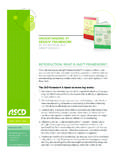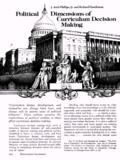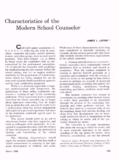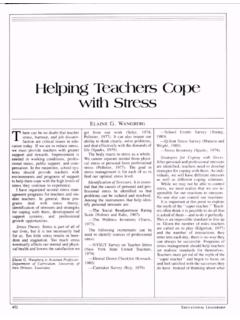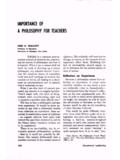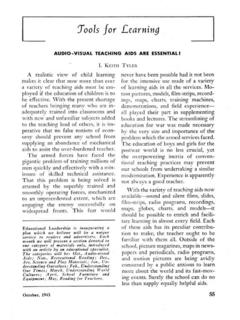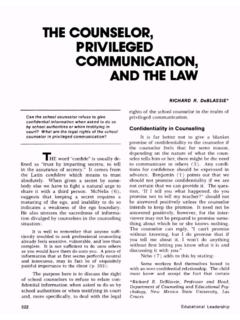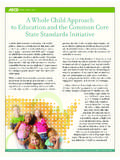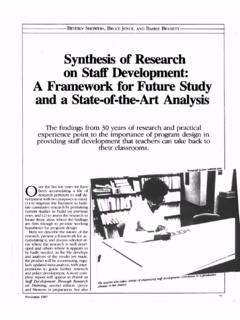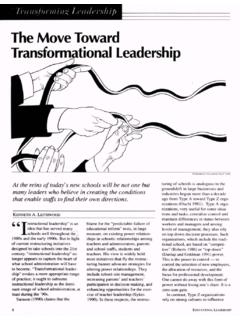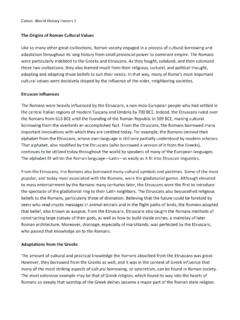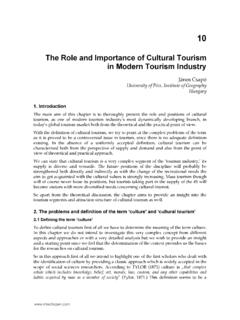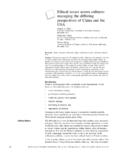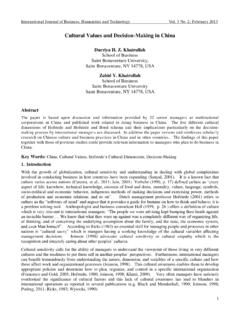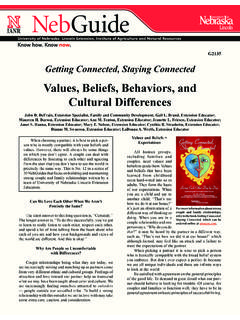Transcription of Cultural Values and Learning in Thailand - ASCD
1 EUNICE S. MATTHEWC ultural Values and Learning in ThailandThe Thai people are sensitive to their own rich heritage and alert to new and emerging Values as they adjust their schools to modern HISTORY of public educa tion in Thailand dates from the progres sive action of King Chulalongkorn in the late 19th century. Around 1855 he began sending royal princes to England, Germany, Russia and Japan to study Western and other distinctive ways for introduction into programs for the wel fare of the Thai nation. His concern for strengthening the kingdom to withstand the rising tide of foreign colonial expan sion in the region led to the establish ment of a school in the palace, and other schools in Bangkok and key loca tions in the country. The main purposes of these early schools were to train gov ernment officials and to provide literacy instruction as a means of arousing na tional consciousness and patriotism among the people.
2 By 1921 a national system of compulsory primary educa tion was adopted. It was not until after 1932, however, that this policy became widespread in the rural after the classical European systems of education, particularly the British, Thai schools have aimed at pre paring Thai citizens in the manner of the scholarly gentleman of leisure. From the earliest periods of Thai history, thekings and royal princes were noted for favoring artists, dancers, poets, and dramatists, some of whose works have formed standard content in the school curriculum. The emphasis in formal edu cation came to be put on the develop ment of an intellectual elite who ab sorbed the type of scholarship which would not only equip them for advanced studies abroad, but would also qualify them for membership among the aristo crats of the Thai social level of the educational organi zation has had its part to play in main taining the Values of the ruling class.
3 The four-year compulsory primary E ~ F= chool has sought to provide mainly literacy training and a basic un derstanding of Thai nationality. Rigor ous examinations at the end of each grade resulted in high percentages of children repeating a grade several times until they often reached the school - leaving age of 15 and yet had only com pleted the third grade. The examinations required for entry into the six-year sec ondary ( ~ ~ ) school again elimi nated large numbers of children. For those who wished to continue their edu cation, vocational courses were intro-April 1959419V " *PHOTO COURTESY THE AUTHORC hildren in Chachoengtao school learn cla ical Thai dance* and These usually lacked attraction because education had to he academic to be esteemed; besides the trades did not convey the respectability ascribed to white collar jobs, especially the jobs in the civil service.
4 The students who went on to complete the secondary school would again have to qualify for entrance to the two-year university preparatory courses before finally standing for ad mission to the the program of studies listed for the sqhool has contained a full regimen of subjects, certain areas have had traditional weight and emphasis, in dicating their importance in Thai cul ture. The study of Thai language and literature is regarded, even in the pri mary school, as more than just literacy training. It is a means of developing "the golden tongue." The use of well-chosen words, witty and poetic, with allusions to classical Thai literature and in the manner of a Thai nobleman, is the mark of an educated man or woman. The study of Buddhism is a constant in every curriculum and serves as a strong re minder of the qualities of ethics which the ideal Thai must understand and prac tice for fundamental self-realization and full enlightenment.
5 Thai history, with incidental references to geography and420 Educational Leadershipto other countries, is another area to which a large portion of the curriculum is devoted. It is aimed at instilling a deep national pride in the feats of the royal ancestors and the past glories of the kingdom. Of increasing importance is the study of the structure and workings of the constitutional form of govern ment as well as of the duties of every Thai Educational ReformsEducation in Thailand since World War II has been assuming new directions as a result of an enormous amount of experimentation which seems to he in support of some definite social and cul tural changes. Of new and compelling significance is the reliance which the government is attempting to place upon the people to advance the quality of living in each community through a broadening of the peoples responsibil ities, through the provision of educa tional opportunities, and through the utilization of all available resources and talents; thus Thailand would be enabled the better to meet the challenges at home and in the international 1950, the Ministry of Education has initiated pilot studies, starting with the one in Chachoeugsao, a province 60 miles from Bangkok, and extending to other provinces in the kingdom.
6 The Chachoeugsao Pilot Project ' was or ganized as an in-service training labora tory through which teachers and mem bers of the community could develop a program of effective teaching, functional1 The Chachoen^sao Pilot Project was assisted !>y specialists in community education from UNKSCX), WHO, and IL() and educational specialists from the Internationa! Coopera tion Administation. The Thai directors of the Project were outstanding educationists, main of whom have taken professional training in tile United States. Kurope. Japan, and the Philip , and improved living conditions. Some 233 primary schools, 4 primary- extension schools, 3 secondary schools, 2 vocational schools, and 1 three-year teachers college were of the first efforts of the teachers, principals and supervisors assigned by the Ministry of Education was to analyze how the content of instruction was re lated to the problems of the.
7 Children in their daily living. As a consequence, teachers in study groups developed units of study which enriched and gave sig nificance and a functional slant to the traditionally prescribed content. Chil dren began to explore with their teach ers such matters as how we can/protect our health, how our families can use the new services of the local government of fices (agriculture, cooperatives,, health, adult education), how developments such as the construction of a new dam, the increased air travel in the country, new highways, etc., were changing the opportunities for Thai people. What the newspapers were saying, curriculum modifications drew heavily on the firsthand explorations of the children and teachers and the results of work done by government and inter national agencies working with adult groups in the various communities.
8 Chil dren began to develop an understanding of the here and now and the ways in which they could shape their world. The school personnel indicated their ap proval of such approaches as would pre-~ pare the children for necessity to consider ways by which all children could be helped to learn more effectively became apparent. There was concern for the large num-EU1\ICE S. MATTHEW it atnstant pro- fessor of education, Brooklyn College. Brooklyn, PH. 1 959421her of children who had difficulty meet ing ,the requirements of the course of stddy, for example, that all number facts be mastered in the first and second grades using both Thai and Arabic figures. There was concern also about the many children who could not read or write well enough to achieve func tional literacy by the fourth grade, which was the customary terminal point for most were generally lectured to or asked to copy notes from the black board and memorize them for the ex aminations.
9 The text used by the teacher as her "lecture" reference with perhaps a few more texts among the children for reading practice, the children's copy books, and a small blackboard before the class were the only materials in use. Instruction seemed to be based on the idea Confucius expressed, "When I have presented one corner of a subject to anyone and he cannot learn from it the other three corners, I do not repeat the lesson."Study groups of teachers analyzed the needs, abilities, motivations, previous experiences, and responses of children to Learning -teaching situations. Most of the teachers, who for the most part had had limited professional training, were eager to try "modern methods of teach ing" or " Learning by doing" because they had heard about them in their lectures on modern educational theory, but were not sure how they could be classrooms were changing from lecture rooms into laboratories of provocative, realistic, and effective work.
10 Children were planning, working in groups on their level with more under standing and specific guidance by their teachers, going on field trips, working with word pocket charts, building ex perience stories, receiving developmentalguidance for new concepts and skills, re vealing their insights in discussions, home and school projects, art work, dramas using classical Thai dancing, in writing, experimenting to test scientific- principles, analyzing instructional mate rials prepared by teachers in workshops, giving programs for their parents and other classes, and promotions became more qualitative than quantitative. Some- valuable and encoviraging investigations began in an attempt to ascertain the Learning achievements of the children in these experimental schools.
